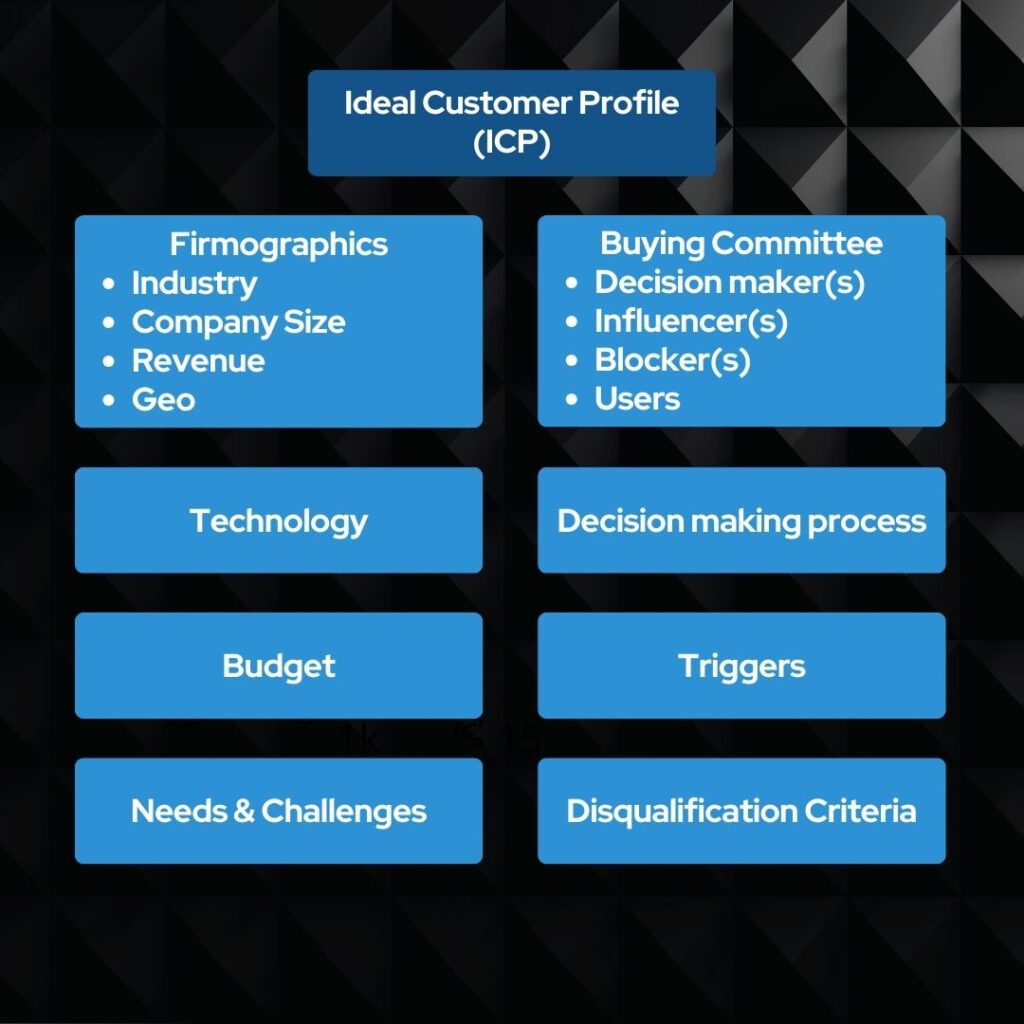Every B2B marketer knows that not every potential customer is worthwhile for your company. Developing an ideal customer profile or ideal client profile (ICP) is crucial to focus your marketing efforts on businesses that are most likely to convert and form long-term, valuable relationships with your company.
But what makes a client profile “ideal” for B2B companies? In this article, I’ll show you what that is and how to create an effective B2B customer profile yourself.
The Basic Concepts of an Ideal Customer Profile (ICP)
The ideal customer profile describes the fictional account that possesses all the characteristics of your best customers from a specific market segment. It is a description of the type of customer who will stay with you the longest and cost the least to acquire.
This profile helps guide both marketing and sales efforts by clearly identifying who your target market is.
The ideal customer profile gives you: focus, clarity on which channels to deploy where your ICP is present, personalization opportunities, and account qualification and disqualification for list-building companies.
Characteristics of an effective customer profile

- Industry: What industries are your ideal customers in?
- Company size: Are you targeting SMBs, startups, or large enterprises?
- Revenue: Under 1 million per year or above?
- Localization: Are there geographic limitations or opportunities in where they are located?
- Technology: do they use Microsoft or Google services, Google Ads or LinkedIn?
- Budget: What budget do they typically have available for your type of services or products?
- Buying committee: Who makes the decision, who influences the decision? But also: who can counteract the decision (blocker) and who will end up using your solution? What roles are these? And what other characteristics do they have: e.g., what age?
- Needs and Challenges: What specific problems can you help them with?
- Decision Processes: What do their purchasing processes look like and who are the key characters in them?
- Triggers: What is a specific trigger to be looking for your solution? E.g. an acquisition, a new product, a new customer, a promotion of someone in the DMU, etc.
- Disqualifying Criteria: What characteristics can be named that make a company precisely not meet your ideal customer profile? Examples can be no marketing department present, a marketing manager has only been employed for 1 year, or a company without venture capital. This also lets you know what kind of company does not suit you: that gives a lot of clarity.
An important mistake I often see when creating an ICP is to rely only on the first 4 characteristics by focusing on industry, location, revenue, and number of FTE (aka the firmographics of a company). This often results in too large a target audience, so be sure to make this specific.
The Benefit of a Clear Customer Profile
A well-defined ICP not only helps identify and target the most suitable prospects, but also optimizes your marketing budget by allocating resources to the channels where these prospects are most active. In addition, with this you improve collaboration between marketing and sales by establishing a common target audience.
How Do You Develop An Ideal Customer Profile For Your B2B Company?
Developing an ICP requires thorough research and analysis. Here are step-by-step instructions to get you started.
Analyze Your Current Customer Base
- Take a look at your existing customers: Who are your most profitable and loyal customers? Identify commonalities among them.
- Analyze interactions: Dive into CRM data to find patterns in how these companies interact with you.
- Research feedback: What are these companies saying about your product or service? What benefits do they often emphasize?
Research Your Market And Competition
- Look at market trends: Are there shifts that offer new opportunities for certain sectors or company sizes?
- Analyze competition: Who are they targeting? Can you find gaps in their strategies that offer opportunities for you?
Interview Those Who Fit Your Ideal Client Profile
If you don’t have clients yet, interviewing people who seem to be in your ICP will help you get more clarity on your ideal client profile. And if you do have clients, you can interview those who meet your ICP to get certain answers you didn’t already have or just confirmation of characteristics you had already described.
Whenever we get start with a new client, we always interview a few clients to confirm and refine the ICP. The interviews are online meetings, so we record the videos and use them – with permission – for testimonials as well. Win-win!
And you can also use surveys or ask questions on social media. Approach people in your network on LinkedIn and see if you can use this to refine your ICP.
Build Your Ideal Customer Profile
Once you have collected enough data, combine it into one cohesive profile. Be as specific as possible; this will serve as a guideline for all your future marketing and sales activities.
Your ICP Is Not Static: Refine Your Ideal Customer Profile Regularly
Be flexible in your approach. Because market conditions are constantly changing, be prepared to adjust your ICP when necessary.
I recommend to take a good look at your ideal client profile at least once a year, if only to tighten your account disqualification factors 🙂 .
What Is The Difference Between The Ideal Customer Profile And Buyer Personas?
The buyer personas are part of your ideal customer profile. These are the people in the buying committee. They do the negotiating or they can influence the deal.
The Ideal Customer Profile Is Essential For B2b Companies
A well-defined ideal customer profile (ICP) helps you focus on the most valuable potential customers, making your marketing and sales efforts more efficient.
Get started setting up your ideal customer profile yourself or contact us so we can get started on this together!
